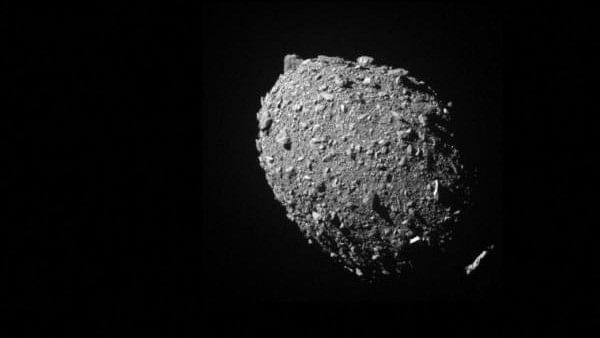
Asteroid moonlet Dimorphos. (Image for representation)
Credit: Reuters File Photo
Astronauts embarking on long-haul journeys in deep space can't pack all the calories they will need in the form of freeze-dried food. They also can't grow everything they'll need, as onboard garden technology isn't mature enough to keep them flush with fresh produce. Given those nutritional constraints, a group of engineers think future space travelers should pivot their diets.
In a study published Thursday in The International Journal of Astrobiology, scientists suggest that astronauts could look to asteroids for all-you-can-eat meals.
They wouldn't be chomping down on the rocks themselves. Instead, a chemical and physical process would break down an asteroid's material, and the resulting organic components -- hydrocarbon compounds -- would then be fed to bacteria. After the bacteria were full, the astronauts could consume the collection of microbes, more appetizingly referred to as "biomass."
This idea has origins in a more earthly project, sponsored by the Defense Advanced Research Projects Agency of the US Department of Defense. One of the agency's programs, ReSource, tasks researchers with taking waste produced by troops and turning it into something useful. Trash to treasure, in other words.
One team working on ReSource has been investigating what to do with "meals ready to eat," or MREs, military rations that last many years. But the plastic containers that hold soldiers' shelf-stable beef last even longer.
"They don't want to throw them away. They don't want to burn them. They don't want to pack them out," said Joshua Pearce, an engineering professor at Western University in Ontario who is collaborating on the project, which is led by researchers at Michigan Technological University. Maybe, his team thought, they could turn those plastic food containers into more food.
The first step in that process breaks the plastic down using pyrolysis, "basically just cooking without oxygen," Pearce said. That breakdown yields a solid, a gas and an oil. The oil then goes into a bioreactor, where bacteria eat what they are given. And, finally, when the bacteria finish feeding, they become the food. The biomass has nutritional properties similar to food we eat every day.
The team's first attempts at creating MRE biomass weren't appetizing: They produced "a flesh-colored slurry," in Pearce's words. Later, they created something more like caramel yogurt. Whether that yogurt is federally edible is another question. "We have to go through all of the rigorous safety studies to ensure that they are nontoxic," said Stephen Techtmann, a Michigan Technological University microbiologist leading the project.
Pearce was discussing this plastic work with his "space friends," who pointed out that asteroids aren't so different from plastic, at least from the microbes' perspective: They both contain a lot of carbon.
"Well, OK, let's take this seriously, and figure out exactly how much carbon there is, and if it's in the right form, and if we think that we can convert it into food," Pearce said, describing the thought process.
Those answers rely on whether microbes will, in fact, eat asteroids. That's something Annemiek Waajen of Vrije Universiteit Amsterdam has investigated, feeding bacteria meteorite material -- pieces of space rock that have fallen to Earth. "If we just feed microbes fresh, pristine meteorite, what would happen?" she asked.
They consumed its carbon and grew, according to her research, published in the journals Astrobiology and Scientific Reports. Meteorites, Waajen said, may have helped the early Earth to be habitable and influenced initial life's evolution: Early single-celled organisms would have had an abundance of space rocks around. "A lot of meteoritic material rained down on the surface around the same time as life originated," Waajen said.
Given the meteorite-eating bacteria, and the maybe-edible plastic microbes, Pearce thought the idea that asteroids could become food was reasonable. After all, the actual biochemical process should be roughly the same as with plastic. And so he and his space friends, authors of the new paper, did some math, calculating how much food an asteroid could hypothetically produce.
The researchers used the asteroid Bennu as their model space rock. NASA's OSIRIS-REx mission returned to Earth last year with a canister filled with material from the asteroid. According to NASA, Bennu's total mass is about 85.5 million tons.
Based on its size and carbon content, "it fits in that nice window of possibly making a tasty treat," Pearce said.
Assuming a worst-case situation, in which the conversion of material was inefficient, the group calculated that, if broken down by microbes, the compounds on Bennu could support one astronaut for about 600 years. If conversion were more ideal, that astronaut could eat for 17,000 years. Put more practically, to support one astronaut for one year, one would need between 5,500 and 175,000 tons of asteroid.
Before anyone begins chewing on space-rock bacteria, though, the researchers will have to do the same kinds of toxicity tests happening in the plastic work.
Waajen, who isn't part of the research, thinks asteroid food makes sense biochemically, but that it will remain a curious idea for a while. "It is something that's still a long way away," she said. After all, scientists would first have to build an asteroid mining capability and a giant bacterial food factory ... in space.
The space part is what gives Techtmann, who didn't collaborate on that line of research, pause. What his team has learned down here won't necessarily work up there. "How do those assumptions actually translate when you get it into that environment?" he said.
Also, asteroids are not chemical clones of one another. "Changing from asteroid to asteroid might be challenging," he said.
Pearce is willing to try to sort that out and, in the meantime, to continue the terrestrial side of the work -- hoping to gather data demonstrating that the biomass meals are safe.
"I already promised I'll be the first one to take a bite," he said. "If I survive, we can move on to grad students."